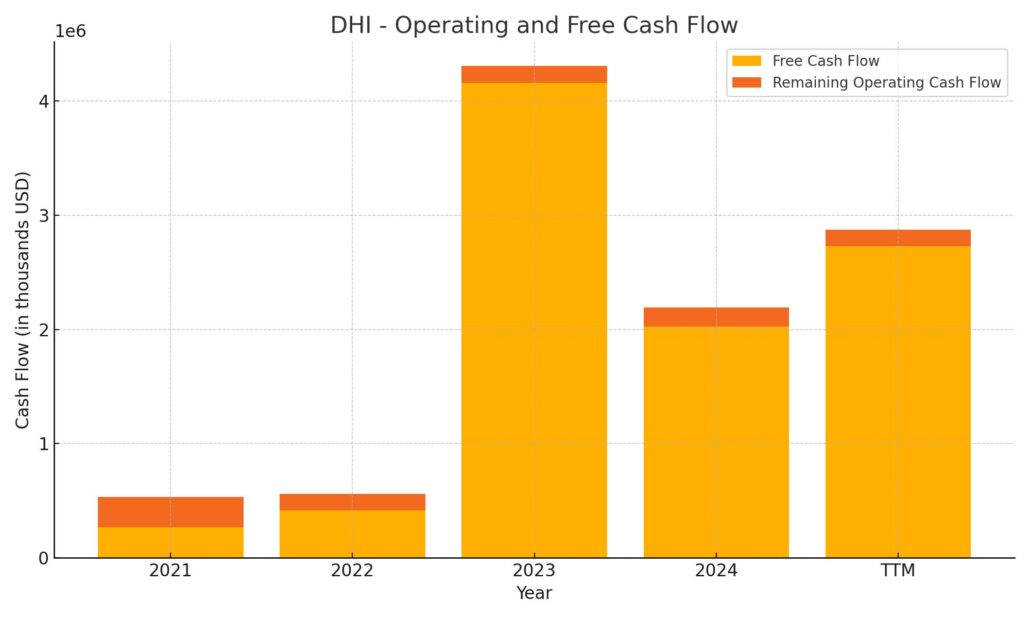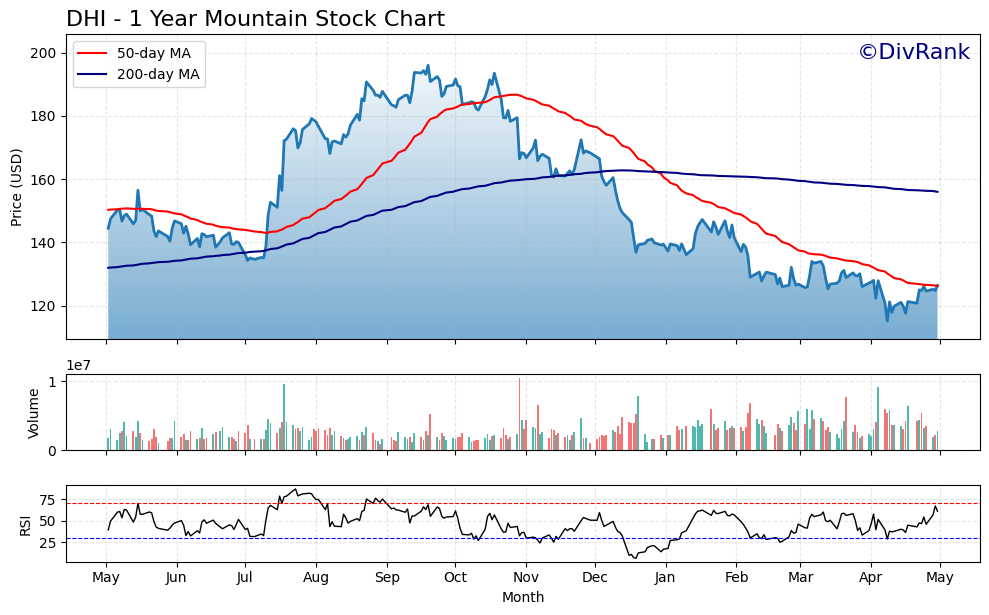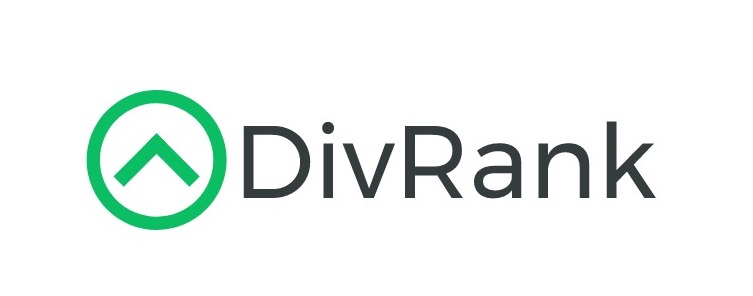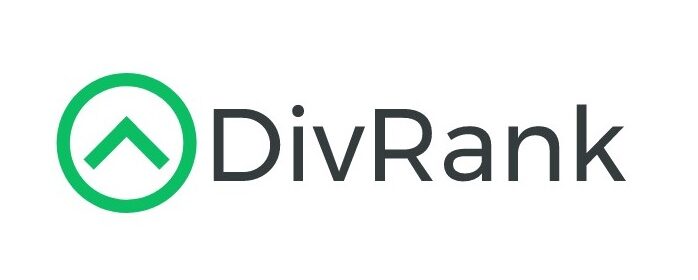Key Takeaways
📈 D.R. Horton offers a forward dividend yield of 1.27% with a low payout ratio of 10.61%, and has grown its dividend at an average rate of 22% annually over the past five years.
💵 Free cash flow for the trailing 12 months was $2.73 billion, supported by strong operating cash flow and conservative capital expenditures, maintaining a solid cash position.
🔍 Analyst sentiment has cooled, with several firms lowering price targets due to affordability concerns, but the consensus target remains around $152.79, suggesting potential upside from current levels.
📊 The most recent earnings showed a dip in revenue and closings, with management citing affordability and softer demand; however, gross margins held steady and the company raised its buyback plan to $4 billion.
Last Update: 5/1/25
D.R. Horton (NYSE: DHI), the largest homebuilder in the U.S. by volume, continues to show resilience through shifting market conditions. The company operates across 45 states with a diverse product range, from entry-level to luxury homes. Backed by a leadership team with deep experience and a disciplined approach, DHI has consistently prioritized operational efficiency, cost control, and strategic adaptability—qualities that stand out in today’s higher-rate environment.
Despite a slower spring selling season and some downward revisions in revenue and closing forecasts, the business remains solid. DHI continues to generate strong free cash flow, maintain healthy margins, and support shareholder returns through growing dividends and expanded buybacks. With its stock trading at a modest valuation and supported by a proven operating model, the company offers a stable foundation for long-term investors focused on fundamentals and consistent execution.
Recent Events
The housing market has been through its share of ups and downs recently. With mortgage rates staying stubbornly high and affordability becoming a challenge, homebuilders like D.R. Horton are being tested. The company’s latest results reflect that pressure. Revenue over the past twelve months landed at $35.3 billion, but that’s down 15% compared to the year before. Earnings also took a hit, with a 31% year-over-year decline.
Despite the dip in growth, the business itself remains sturdy. Profit margins are still in healthy territory—net margin stands at 12.15%, and return on equity is a strong 17.65%. These aren’t the kind of numbers you see from a company in trouble. Instead, they speak to operational resilience and tight cost control.
On the balance sheet, DHI is sitting on more than $2 billion in cash and carries a manageable $6.6 billion in total debt. Its debt-to-equity ratio is just 26.6%, which is low for a company in a capital-intensive industry like homebuilding. Liquidity is no issue here either, with a current ratio nearing 7. All of that points to a business that’s well-equipped to continue paying dividends and investing in its future, even in a tougher economic environment.
There’s also a near-term dividend event for those looking to lock in income. The next dividend is set for May 9, with the ex-dividend date falling on May 2.
Key Dividend Metrics
📈 Dividend Yield: 1.27% (Forward)
💰 Payout Ratio: 10.61%
🔁 5-Year Average Dividend Yield: 0.93%
📆 Next Dividend Date: May 9, 2025
🪙 Dividend Growth Rate (5-Year Avg): ~22% CAGR
🔒 Dividend Safety: Excellent
Dividend Overview
At first glance, DHI’s dividend yield might not jump off the page. The forward yield sits at 1.27%, which isn’t high enough to satisfy every income investor. But the real story lies under the surface. The company has increased its dividend at a much faster clip than many of its peers, all while keeping its payout ratio extremely conservative.
Right now, DHI is only paying out a little over 10% of its earnings as dividends. With EPS at $13.19 and an annual dividend of $1.60, there’s a significant margin of safety. This leaves the door wide open for future raises, even if earnings growth slows.
Compared to its own history, today’s dividend yield is actually more attractive. The five-year average is just 0.93%, so the current yield represents a premium relative to where the stock has traded in the past.
Another subtle but important note—this isn’t a management team that pushes for yield at the expense of stability. The dividend strategy here is deliberate. Modest quarterly increases that reflect long-term confidence rather than short-term noise.
Dividend Growth and Safety
This is where D.R. Horton really shines. Over the past five years, its dividend has grown at an average annual rate of about 22%. That kind of growth, combined with the low payout ratio and strong financial footing, puts DHI firmly in the camp of safe and dependable dividend growers.
Operating cash flow over the past year came in just under $2.9 billion. Even after reinvesting in the business and paying down debt, DHI had nearly $1.3 billion in free cash flow left over. That’s plenty of breathing room to continue rewarding shareholders while also funding expansion or strategic initiatives.
What’s also reassuring is the steadiness of those increases. There’s no erratic pattern here—no skipped years, no sudden slashes. Just reliable upward movement, year after year. That kind of consistency suggests the dividend isn’t just a side benefit, it’s part of the company’s identity.
Volatility-wise, DHI does move more than the broader market, with a beta of 1.62. That’s common in the housing sector, especially with interest rates as volatile as they’ve been. But for investors willing to ride out those swings, the dividend offers a steady anchor. And thanks to that low payout ratio and strong earnings base, there’s little risk of disruption—even in a softer housing cycle.
DHI may not be the first name that comes to mind for dividend investors, but it deserves a second look. Between its disciplined approach to capital allocation, consistent earnings power, and double-digit dividend growth, the company has quietly become one of the more reliable dividend growers in the homebuilding space.
Cash Flow Statement
Over the trailing twelve months, D.R. Horton generated $2.87 billion in operating cash flow, a significant rebound from $2.19 billion in the prior fiscal year. This improvement reflects the company’s ability to convert earnings into real cash despite a slowdown in revenue and earnings growth. Free cash flow over the same period came in at $2.73 billion, which remains strong even compared to fiscal 2023’s already healthy $2.02 billion. These numbers indicate the core business remains highly cash-generative and capable of funding dividends, buybacks, and future growth without stretching the balance sheet.

On the financing side, the company was far more active, pulling back a notable $3.23 billion—more than double the outflow in 2023. This included substantial repurchases of stock and continued debt repayments. Investing cash flow remained stable at around $219 million in outflows, mostly tied to manageable capital expenditures of $141 million. The overall cash position did decline to $2.52 billion from $4.54 billion a year earlier, but the decrease was primarily due to capital returns and debt management, not operational strain. D.R. Horton’s cash flow profile remains solid, driven by a disciplined approach to capital and consistent underlying profitability.
Analyst Ratings
📉 In the past few weeks, D.R. Horton has come under the microscope after a softer-than-hoped spring season and a trimmed full-year outlook. 🎯 The average analyst price target now sits at $152.79, with a wide range spanning from $105 on the low end to $215 on the high. Think of that spread like weather forecasts for a shifting front—analysts are reading the same data, but reaching very different conclusions.
🏠 Keefe, Bruyette & Woods dialed back their price target from $165 to $135, sticking with a neutral “Market Perform” stance. 🏚️ JP Morgan sees more headwinds, cutting its target from $132 to $111 while keeping an “Underweight” label. 🧱 RBC Capital turned even more cautious, lowering their target from $125 to $105 and maintaining an “Underperform” call. Even Barclays trimmed their target from $120 to $110, holding onto their “Equal-Weight” view.
📊 These moves came on the heels of a tough earnings report, where D.R. Horton not only missed estimates but also reduced its expectations for home sales and revenue. Rising mortgage rates, affordability concerns, and a slower-than-usual spring selling season were cited as reasons—like a builder working through stormy weather, the company is facing some near-term visibility issues.
🌤️ Not everyone is seeing clouds, though. JMP Securities stayed bullish, maintaining a “Market Outperform” rating while easing their target from $210 to $180. Wells Fargo echoed that sentiment, holding their “Overweight” position with a revised target of $160, down from $175.
📍 While the consensus tilts toward “Hold,” it’s clear there’s a tug-of-war happening between near-term market pressures and longer-term confidence in D.R. Horton’s underlying strength.
Earning Report Summary
Slower Quarter Than Expected
D.R. Horton’s second quarter of fiscal 2025 came in a bit softer than what many were hoping for. Earnings landed at $2.58 per share, falling just short of expectations, and revenue dipped 15% year-over-year to $7.73 billion. Home closings also pulled back, down 15% from the same time last year, totaling just over 19,200 units. Even with those declines, the company managed to hold its gross margin at 21.8%, which is a positive sign in a tough market.
Executives didn’t shy away from the reality of the situation. Executive Chairman David Auld called out the slower spring selling season and pointed to affordability pressures and consumer sentiment as the key headwinds. CEO Paul Romanowski was candid but confident, emphasizing that D.R. Horton is adjusting its product offerings and incentives depending on what each local market needs. He also highlighted the company’s size as a key advantage, helping it navigate rising material costs and supply constraints more efficiently than smaller competitors.
Eyes Forward, With Some Adjustments
Looking ahead, the company made a few downward revisions to its full-year guidance. Revenue is now expected to come in between $33.3 billion and $34.8 billion, trimmed from a previous range of $36 billion to $37.5 billion. Forecasted home closings were also lowered, now expected to hit between 85,000 and 87,000 units.
Even with those tempered expectations, leadership sent a clear signal that they still see long-term strength in their position. One example of that confidence is their decision to increase the share buyback program to $4 billion for the fiscal year. That kind of move says they believe in the value of their business and aren’t rattled by short-term bumps.
Overall, the tone from the top was pragmatic. The company sees where the pressure points are—like affordability, buyer hesitation, and input costs—but they also trust in their ability to adapt and keep building, both literally and strategically.
Chart Analysis

Price Trend and Moving Averages
Looking at the one-year chart for DHI, the price action tells a story of early momentum followed by a steady slide. The stock began climbing in late spring, pushed up past $180 by the summer, and even flirted with $200 in the fall. That was the high point. Since then, the trend has clearly reversed.
The 50-day moving average (red line) crossed above the 200-day (blue line) around July, confirming a bullish stretch. But by early January, the opposite had occurred. That crossover back below the 200-day marked a shift in momentum, and the stock has been trending downward since. Currently, the price remains below both moving averages, which suggests the downtrend is still intact, although the recent bounce in late April might be worth watching.
Volume and RSI
Trading volume has remained fairly steady, with occasional spikes, but no persistent increase to suggest aggressive institutional buying or selling. The volume isn’t sending any loud signals right now—more like a quiet churn as the stock drifts.
The RSI, however, is showing something a bit more interesting. It’s pushing toward the overbought zone again, nearing 70. That could be interpreted as a sign of short-term enthusiasm, though the last few times this happened, it was followed by a pullback. If this momentum is going to last, it needs to be backed by volume and a break above the moving averages.
Overall Impression
This chart shows a stock that had a strong run but lost momentum and hasn’t yet regained a firm footing. There’s potential support building just above $120, and the price has started to lift slightly off those lows. But until it climbs back above the moving averages with conviction, the trend remains cautious. This isn’t a breakout—at least not yet. It’s more of a watch-and-wait setup, where time will tell if the recent strength has real staying power.
Management Team
D.R. Horton’s leadership remains one of its most consistent strengths. David Auld, now Executive Chairman, previously served as CEO for nearly a decade and has been with the company since the late 1980s. His steady, grounded leadership style has helped shape a strategy focused on operational discipline and measured growth. Taking over the CEO role is Paul Romanowski, a long-time company veteran who’s been with D.R. Horton since 1999. He brings decades of field and executive experience, with a clear focus on execution and local market responsiveness.
This management team doesn’t chase hype or overextend during boom cycles. Instead, their strategy centers on flexibility, regional diversification, and protecting margins through efficiency. That mindset has helped the company consistently outperform peers through both upturns and downturns. Romanowski has emphasized adapting the product mix and incentives to fit current affordability pressures. Their leadership understands how to manage a large-scale operation without losing sight of local demand trends. It’s this calm, experience-driven approach that has helped keep D.R. Horton operating from a position of strength, even when the broader housing market faces pressure.
Valuation and Stock Performance
From a valuation standpoint, the stock looks compelling. DHI trades at under 10 times trailing earnings, with a forward price-to-earnings ratio just above 11. That’s low relative to the market and to other homebuilders, especially considering the company’s consistent earnings power, double-digit net margins, and strong return on equity. D.R. Horton is still producing more than $35 billion in annual revenue, and profitability remains healthy, yet the valuation doesn’t fully reflect that strength.
Stock performance over the past year has been less encouraging, with shares falling from a high near $200 to around the $120 mark. That decline mirrors broader market concerns about housing demand, rate pressures, and slowing consumer activity. But from a long-term lens, this pullback has brought the stock back to more attractive levels, especially for investors looking beyond the next few quarters.
Despite the dip in price, the company hasn’t pulled back on its shareholder returns. The dividend continues to rise gradually, and management has increased its share repurchase program, targeting up to $4 billion in buybacks for the year. That signals confidence in the underlying business and a commitment to returning value to shareholders, even during a slower sales period.
Risks and Considerations
The most pressing risk facing D.R. Horton is affordability. Higher mortgage rates have made it more difficult for many buyers, especially first-timers, to enter the market. That pressure has been a key drag on demand, particularly in price-sensitive segments where D.R. Horton has a strong presence. If interest rates stay elevated for an extended period, or rise further, housing demand could continue to soften.
Input costs also remain a wildcard. Materials like lumber have stabilized somewhat, but labor shortages and development expenses still pose margin risks. While D.R. Horton’s scale helps manage these fluctuations, unexpected shifts in supply chains or inflation-related pressures could still impact earnings.
The company is also exposed to regional risks. Although it operates nationwide, certain key markets, particularly in the South and West, have experienced significant price run-ups in recent years. A slowdown or correction in those regions could impact closings and margins.
Broader economic uncertainty adds another layer of risk. If job growth slows or recession concerns increase, consumer sentiment could weaken further. While D.R. Horton is built to weather downturns, no homebuilder is immune to sharp declines in buyer confidence or purchasing power.
Debt management has been solid, but it’s something to monitor. As interest rates rise, borrowing for land acquisition or expansion could become more expensive. For a growth-focused builder, that could mean tighter capital allocation and slower community development.
Final Thoughts
D.R. Horton has built a reputation as one of the most resilient players in the housing industry. It’s a company that thrives not by chasing trends, but by sticking to a disciplined, scalable model and adjusting quickly to shifting demand. Leadership understands the rhythm of the market, and the strategy of staying flexible and conservative has paid off repeatedly over the years.
The pullback in the stock has reflected real concerns—slowing sales, affordability issues, and a tougher interest rate environment. But underneath that is a business still delivering strong cash flow, steady margins, and long-term value. The fundamentals remain intact, and the balance sheet is positioned for stability, not risk.
While short-term uncertainty may continue, the company’s ability to adapt, manage costs, and maintain profitability sets it apart. D.R. Horton isn’t aiming for aggressive expansion during a slowdown. It’s focused on what it can control—operating efficiently, protecting returns, and maintaining a solid foundation. That kind of approach tends to win out over time.

